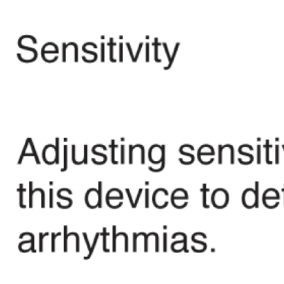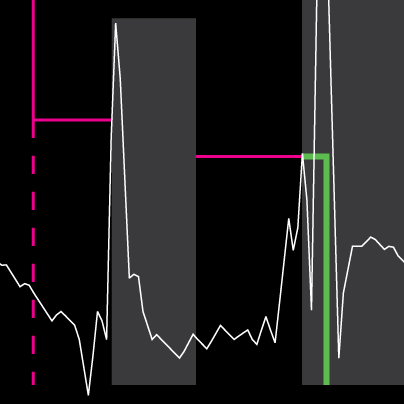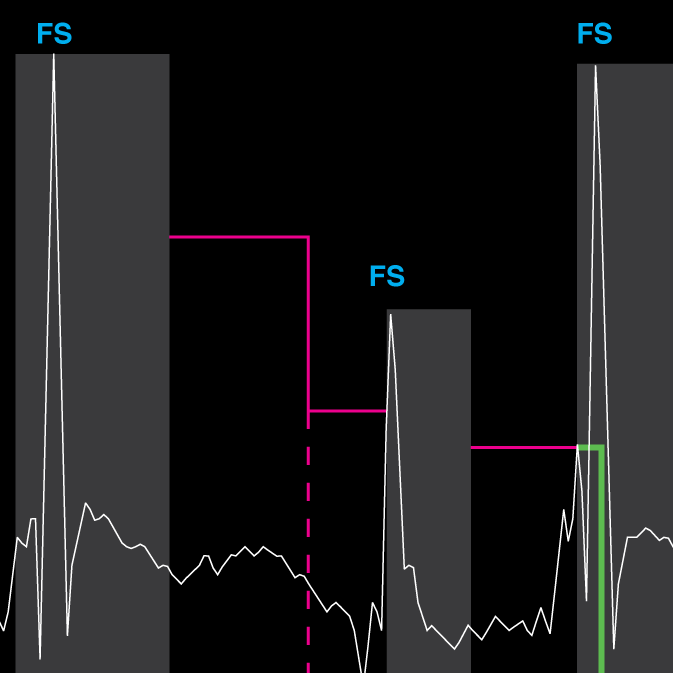The problem was that every time David turned on the toaster, they took away his driver’s license.
For six months, we worked with nine field staff, one physician, and three nurses during our research and design. One of them shared this story with us.
David (not his real name — but this is a real case) is one of thousands of people with an implantable cardiac defibrillator (ICD). Its job is to observe the electrical activity of the heart, and if it sees something dangerous, deliver a 40 J shock — that’s like getting a can of paint dropped on your chest. It’s so traumatic that people frequently pass out when it happens.
The big problem with David’s device is the lead. It sits outside of his heart, acting like a giant antenna for electromagnetic radiation. Now, every ICD has a way of filtering out noise, and for most, it’s a simple matter of making the system less sensitive to electrical activity. Too sensitive, and you get an electric shock because the lead picked up the noise from your toaster and thought you were about to die.

Physicians and nurses walk a fine line between keeping it capable of seeing fatal activity but not so sensitive that noise can set it off by accident. This is a very common solution to a very common problem — for most people who work with devices, it’s the first thing they do to fix noise problems. Reduce the sensitivity and send the patient home. Tell us next month if it worked.
But David has a new kind of ICD that has its own special filtering algorithm and a set of brand new techniques to deal with noise. If you make David’s device less sensitive, now making breakfast doesn’t knock him out. But it also means that his device can’t tell when his heart is actually in trouble — and David dies. For his device, that first, no-brainer step to solving noise issues is fatal.
 On the left, the red line shows the sensitivity set too low — the beats are being picked up correctly (indicated by the blue arrows) but the noise is also being picked up (red arrows). On the right, no more noise is being picked up, but now beats are being missed (blue outline arrows).
On the left, the red line shows the sensitivity set too low — the beats are being picked up correctly (indicated by the blue arrows) but the noise is also being picked up (red arrows). On the right, no more noise is being picked up, but now beats are being missed (blue outline arrows).
But if you’re a nurse sitting in front of an ICD programmer, there’s a good chance you don’t know that. There’s a good chance you’ve never even seen one of these new ICDs before. You see a noise problem so you make it less sensitive, just like you’ve been trained to.
The trouble is that the screen you work with on the programmer looks exactly like every other ICD. It doesn’t do anything to help you identify that this is a new ICD, and that reducing the sensitivity is the one thing you should never do. In fact, in our research, clinicians told us that their number one fear was someone making this exact mistake and sending a patient home with a device that can’t save their life.
Users need to know how to program the new ICD device safely. So we built an interface that let them, even if they’ve never worked with one before.
 EV-ICD on the left, and a regular ICD on the right.
EV-ICD on the left, and a regular ICD on the right.
Click on a blue circle to learn about the interface.
 1. This area shows the entire collected waveform, and allows users to zoom in the segment they want to work with. ↩
1. This area shows the entire collected waveform, and allows users to zoom in the segment they want to work with. ↩
 2. Tapping these arrows jumps the window to the next batch of waveforms. ↩
2. Tapping these arrows jumps the window to the next batch of waveforms. ↩
 3. If the user adjusts sensitivity, they'll be alerted when they leave the window. For safety reasons, any changes the user doesn't explicitly program get undone if the device loses its connection with the programmer. ↩
3. If the user adjusts sensitivity, they'll be alerted when they leave the window. For safety reasons, any changes the user doesn't explicitly program get undone if the device loses its connection with the programmer. ↩
 4. The algorithm is displayed using the same image and format as the users are trained on. By matching what they already knew, we made it easier for them to take their knowledge and apply it to the system. The algorithm must be set up to correctly differentiate between dangerous and safe waveforms. The real-time updates displayed here allow the user to see exactly how changes to the algorithm lead to changes in differentiation. ↩
4. The algorithm is displayed using the same image and format as the users are trained on. By matching what they already knew, we made it easier for them to take their knowledge and apply it to the system. The algorithm must be set up to correctly differentiate between dangerous and safe waveforms. The real-time updates displayed here allow the user to see exactly how changes to the algorithm lead to changes in differentiation. ↩
 5. Users are looking for FS (fast sense) markers to appear on dangerous arrhythmias. Adjusting the parameters at right causes the device to interpret waveforms different and display different markers here. ↩
5. Users are looking for FS (fast sense) markers to appear on dangerous arrhythmias. Adjusting the parameters at right causes the device to interpret waveforms different and display different markers here. ↩
 6. These parameters are laid out in the order they appear in training. Now, I would put the parameters that are associated with the biggest efficacy on top, and put sensitivity on the bottom. ↩
6. These parameters are laid out in the order they appear in training. Now, I would put the parameters that are associated with the biggest efficacy on top, and put sensitivity on the bottom. ↩
 7. Users need to make sure that the algorithm won't trigger when there's nothing wrong or when there's noise on the lead, but will trigger during a dangerous arrythmia. By allowing users to import recordings of the heart's rhythm previously collected, they can see if their changes would have caught arrhythmias that were previously missed while still avoiding noise. Working with real-time data allows them to make sure that everyday rhythms aren't accidentally detected. ↩
7. Users need to make sure that the algorithm won't trigger when there's nothing wrong or when there's noise on the lead, but will trigger during a dangerous arrythmia. By allowing users to import recordings of the heart's rhythm previously collected, they can see if their changes would have caught arrhythmias that were previously missed while still avoiding noise. Working with real-time data allows them to make sure that everyday rhythms aren't accidentally detected. ↩
 8. Originally, we only displayed one spike at a time. Our users told us they needed to see more to make sure the algorithm was adapting correctly. ↩
8. Originally, we only displayed one spike at a time. Our users told us they needed to see more to make sure the algorithm was adapting correctly. ↩
Users loved it. We made major overhauls that provide visual clues to novices and important information to experts that allow them to effectively work with these new devices. And we took steps to mitigate the risks involved with programming the device. The same users that told us that this problem kept them up at night said that our design addressed all their concerns — and that they wanted something like it on every ICD Medtronic manufactured.
Not only did it make the system safer, it made it easier to train people. Training new users is a significant time sink for our advanced field staff, so this interface would free up their time to sell and implant more devices. This is a cost-savings and revenue-generating design.
So why are there only wireframes?
The simple — and disappointing — answer is: money. There was a pandemic, the project got delayed, and by the time it started back up again, I was already working on something else. I’ve been able to share our work with the new team, and I hope they’ll be able to build it.
